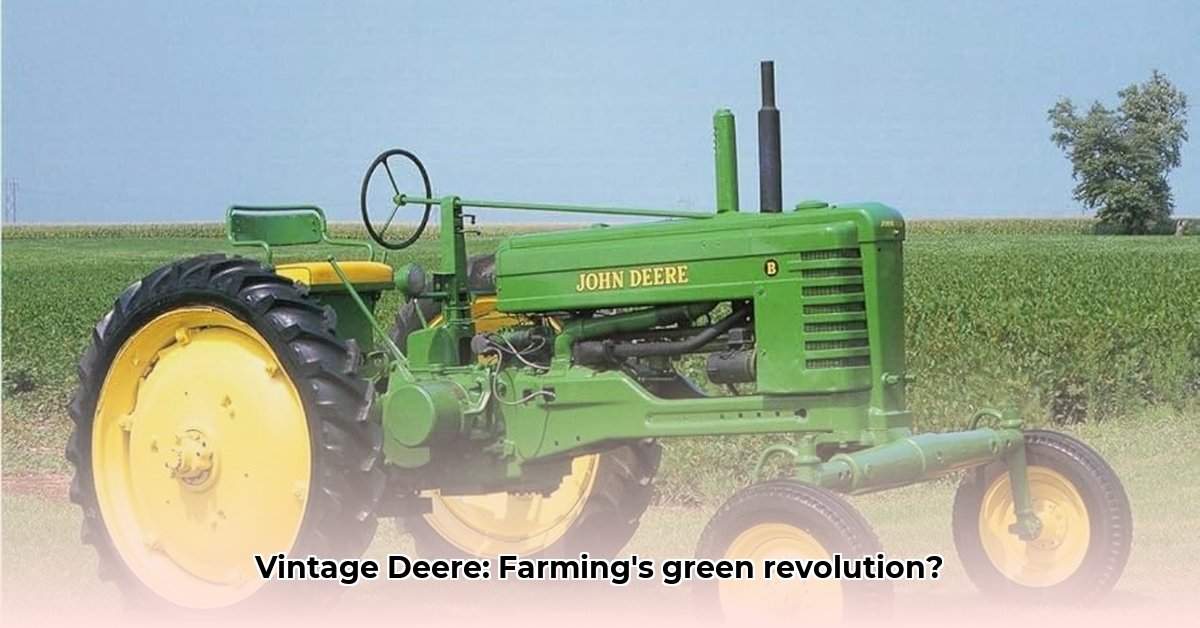
The rumble of a vintage John Deere tractor evokes a powerful image: a simpler time, perhaps, but also a pivotal moment in agricultural history. These iconic green and yellow machines didn't just change how we farm; they fundamentally reshaped rural landscapes worldwide. Their story, however, is complex, interwoven with both remarkable progress and unforeseen environmental consequences. This article explores the rich history of John Deere tractors and their multifaceted impact on sustainable farming—the good, the bad, and the path forward. For more on vintage tractors, check out this site on vintage Farmall tractors.
The Green and Yellow Revolution: Transforming Agriculture
Before the arrival of powerful tractors like the John Deere, farming was incredibly labor-intensive. Imagine relying solely on animal power to plow fields, plant seeds, and harvest crops—grueling work predominantly performed by human hands. John Deere's innovation, starting with the iconic steel plow in the 1800s, dramatically increased efficiency. Subsequent tractor models, such as the Model D and the robust Model R, delivered significantly greater power and speed, enabling farmers to cultivate larger areas and produce more food. This productivity surge was transformative, feeding a burgeoning population and reshaping rural communities. The impact was monumental, shifting farming from a largely manual labor force into a mechanized industry.
However, this efficiency came at a price. While boosting production, these tractors also contributed to farming practices now viewed as potentially unsustainable. Larger, monoculture fields (vast expanses dedicated to a single crop) became prevalent, leading to concerns about soil health and biodiversity loss. This raises a crucial question: Did the increased efficiency outweigh the long-term environmental costs? A comprehensive analysis is needed to fully determine the effects.
Fueling the Green Machine: Efficiency and Emissions
Early John Deere vintage tractors almost exclusively relied on gasoline or diesel fuel—fossil fuels. This dependence highlights a significant environmental downside: substantial greenhouse gas emissions and air pollution. How does the fuel efficiency of these early machines compare to modern tractors? This requires a detailed comparison of fuel consumption per acre worked across various models and periods. Some experts suggest the difference might be surprisingly small when considering the greatly increased yields of modern farming techniques. A thorough investigation is crucial to determine the overall environmental impact.
Furthermore, the remarkable durability of many John Deere vintage tractors, often passed down through generations, presents a double-edged sword. The initial manufacturing cost—in terms of steel, iron, and other resources—was considerable. Their long lifespans also mean some have remained in use long past optimal efficiency, potentially increasing their cumulative environmental impact. And what about the resources needed for decades of maintenance? Repair parts, oil changes, and other maintenance contribute significantly to the overall environmental footprint across a tractor's lifecycle. A comprehensive lifecycle assessment is needed to fully assess the true cost.
The Ripple Effect: Farming Practices and Their Consequences
The introduction of tractors didn't just alter the tools; it changed farming practices themselves. Larger fields, monoculture planting, and increased reliance on chemical fertilizers and pesticides became the norm, largely enabled by the capabilities of machines like John Deere tractors. The long-term implications for soil health, biodiversity, and water resources are profound and complex. Monoculture reduced plant diversity, weakening ecosystems and increasing vulnerability to pests and diseases. While chemical fertilizers boosted yields, they often resulted in soil degradation and water pollution. These interconnected factors created a complex web of environmental consequences, highlighting the need for a holistic approach to sustainable agriculture practices.
From Past to Present: Lessons Learned and Future Directions
Modern agriculture faces unprecedented challenges: climate change, soil erosion, and water scarcity threaten global food security. Against this backdrop, examining the legacy of John Deere vintage tractors is crucial. Their story underscores not only the power of innovation but also the imperative for responsible technological advancement. Can we learn from past mistakes and integrate sustainable practices into the design and use of modern agricultural equipment? This is vital for the future of food production.
Dr. Emily Carter, Professor of Agricultural Engineering at Cornell University, states: "The historical transition to mechanized farming offers valuable lessons. We must prioritize sustainable practices from the outset, not just as an afterthought." This highlights the need for a shift in paradigm, moving beyond mere efficiency gains to encompass a holistic vision of environmental sustainability.
Data-Driven Decisions: The Need for Comprehensive Data
To fully grasp the role of John Deere vintage tractors in sustainable farming, comprehensive data is essential. This includes detailed lifecycle assessments encompassing manufacturing, operation, and disposal; accurate comparisons of fuel efficiency and emissions across tractor generations; and analyses of the environmental impact of associated farming practices (chemical use, soil management, and water usage). This data analysis will equip policymakers and researchers with crucial tools for shaping more sustainable agricultural practices.
A Shared Responsibility: Collaboration for a Sustainable Future
Sustainable agriculture isn’t solely the responsibility of equipment manufacturers like John Deere; it's a shared endeavor involving farmers, policymakers, and consumers. Farmers require access to sustainable technologies, financial incentives for adopting environmentally friendly practices, and ongoing education. Companies like John Deere must prioritize sustainability in equipment design and manufacturing. Policymakers must foster a supportive environment through appropriate regulations and incentives. Ultimately, consumers play a critical role by supporting sustainable farming practices and demanding greater transparency from the food industry.
Looking Towards the Future: A Sustainable Path Forward
The journey towards sustainable agriculture is ongoing. It requires innovation, collaboration, and a deep understanding of the past. The legacy of John Deere vintage tractors—while intertwined with some of today's challenges—can serve as a valuable guide. By learning from past experiences, acknowledging the historical context of technological advancements, and investing in innovative sustainable technologies, we can strive towards a food system that balances productivity and environmental stewardship. The future of food production hinges on this vital commitment.